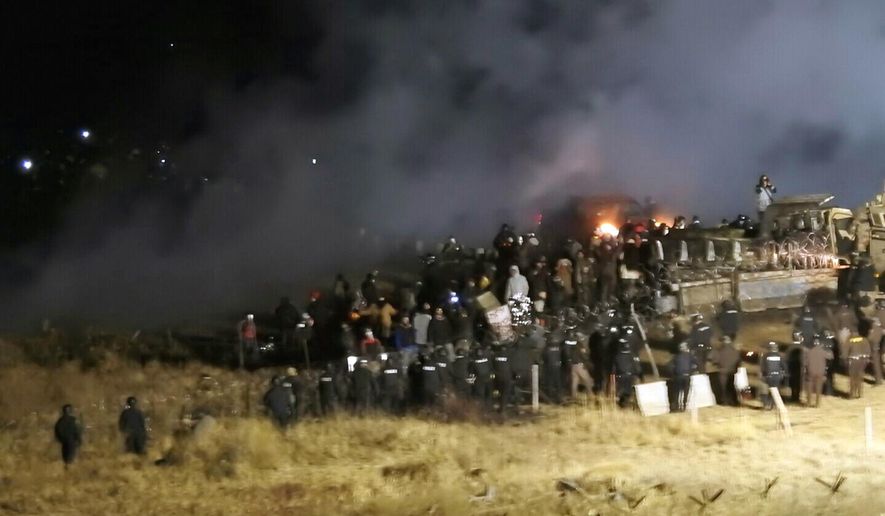A federal judge did Monday what years of protests could not — shut down the Dakota Access Pipeline, at least temporarily.
U.S. District Judge James Boasberg ruled that the pipeline must be emptied while the Army Corps of Engineers produces an environmental impact statement (EIS) on the segment that runs below Lake Oahe, saying the Corps failed to do so when it granted the easement.
“[T]he court asked the parties whether the easement should be vacated and the pipeline emptied during the remand process,” Judge Boasberg said in his 24-page opinion. “Although mindful of the disruption such a shutdown will cause, the Court now concludes that the answer is yes.”
Judge Boasberg, an Obama appointee who sits on the U.S. District Court for the District of Columbia, said that the “[c]lear precedent favoring vacatur during such a remand coupled with the seriousness of the Corps’ deficiencies outweighs the negative effects of halting the oil flow for the thirteen months that the Corps believes the creation of an EIS will take.”
The Corps was sued by the Cheyenne River Sioux and Standing Rock Sioux, which encouraged a mass 2016 protest on federal land to stop the segment that runs under Lake Oahe, about a half-mile from the reservation in North Dakota.
“Today is a historic day for the Standing Rock Sioux Tribe and the many people who have supported us in the fight against the pipeline,” tribal chairman Mike Faith said in a statement. “This pipeline should have never been built here. We told them that from the beginning.”
The $3.8 billion pipeline crosses beneath the Missouri River, just north of the reservation. The tribe draws its water from the river and fears pollution.
The ruling may challenge the legal footing for the Trump administration’s most momentous environmental rollbacks.
Meanwhile, Sen. Kevin Cramer, North Dakota Republican, warned that the looming shutdown — under the order, the pipeline must be emptied of oil by Aug. 5 — would have “devastating consequences for the North Dakota economy and U.S. energy.”
“This terrible ruling should be promptly appealed,” tweeted Mr. Cramer.
After failing to stop the project’s completion, the Standing Rock Sioux sued in 2017 to challenge the environmental review of the Lake Oahe segment, the final piece of the 1,172-mile pipeline that carries crude oil from North Dakota to an oil terminal near Patoka, Illinois.
A Victory for the Oceti Sakowin (Great Sioux Nation): A US District Court has ordered that the Dakota Access Pipeline must be shut down within 30 days so that an adequate, lengthy environmental review may be completed #NoDAPL https://t.co/q05PJujSEb
Environmental groups cheered the temporary shutdown, declaring it a major victory for the Standing Rock Sioux.
“The Dakota Access Pipeline is shutting down!” tweeted Fire Drill Fridays, a climate-change group founded by Jane Fonda. “This is a monumental victory. We owe a debt of gratitude to the Standing Rock Sioux Tribe, Cheyenne River Sioux Tribe, and other indigenous and environmental activists for their tireless work.”
The Indigenous Environmental Network’s Dallas Goldtooth said he was “shaking with excitement,” while 350.org founder Bill McKibben called it “remarkable news,” adding that lawsuits “only work when there’s massive demand for action.”
Thousands of protesters descended on federal land during the summer of 2016 protests, with some setting fires, damaging equipment and blocking roads before the North Dakota blizzards eventually drove the last of the demonstrators away.
The massive clean-up of the area run by Army Corps crews removed 24,000 tons of debris and garbage at a cost of $1.1 million.
“It took four long years, but today justice has been served at Standing Rock,” said Earthjustice attorney Jan Hasselman, who represents the tribe. “If the events of 2020 have taught us anything, it’s that health and justice must be prioritized early on in any decision-making process if we want to avoid a crisis later on. “
Energy Transfer Partners, which runs the pipeline, had no immediate public comment on the ruling.
⦁ This article is based in part on wire service reports.
• Valerie Richardson can be reached at vrichardson@washingtontimes.com.




Please read our comment policy before commenting.